|
Coral Fluorescence in the Marine Aquarium
The Next Frontier of Aesthetics, Husbandry and Aquarium Science Photography by Charles Mazel
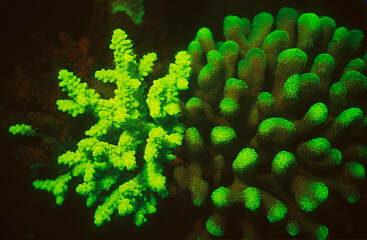
Coral fluorescence is a beautiful, albeit little understood, phenomenon with practical utility to the marine aquarist, and it can easily be observed in the home aquarium with the right equipment and knowledge.
As Doctor Charles Mazel, the worlds leading expert on coral fluorescence explains, fluorescence is the process by which light of one wavelength (color) is absorbed in a substance and transformed into another color. Its not just corals that fluoresce. For example, Mazel explains that phycoerythrin, a photosynthetic accessory pigment found in red algae and cyanobacteria fluoresceses, as do many other reef animals including fish, shrimp, crabs, bristleworms, and more. Seeing these animals fluoresce in your aquarium truly allows you to see your tank and in a whole new light (excuse the pun).
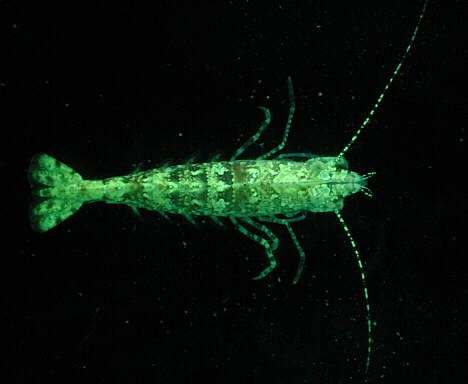
Beyond Beauty
While its unusual beauty is what prompts many aquarists to notice fluorescence in their aquaria, there is also utility involved in this phenomenon. Observing fluorescing animals in your aquarium can lead to better husbandry practices. Using fluorescence, you will immediately notice life forms and animals in different life stages than you have most likely observed before, and the implications for science-minded aquarists and people interested in coral propagation are only just being discovered. Beyond the aquarium, fluorescence has been heralded as the most important biomedical discovery in the last quarter century and is critical to research Alzheimers and cancer research.
What Fluorescence Is and Is Not
But what is fluorescence and how do you see it in your aquarium? First, lets look at what its not. Fluorescence is not the same as bioluminescence, which is a chemical process. Bioluminescence is what is commonly observed in the so-called flashlight fishes and certain marine worms. Fluorescence is also not phosphorescence, in which the substance emitting the light continues to emit the light after the light source has been extinguished. Fluorescence should also not be confused with iridescence, something we commonly observe in marine fishes, for example. So if fluorescence isnt bioluminescence phosphorescence, or iridescence, what it is?
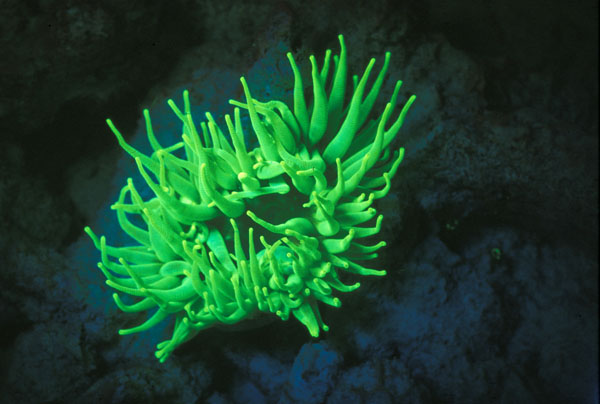
To understand fluorescence, it helps to remember something about light. Light can be measured in wavelengths, which, for practical purposes, is synonymous with color. As Dr. Mazel explains, some corals and other marine animals are able to absorb light energy, change the wavelength and then release it as a different color. The result is an organism that appears to glow so long as an energy source is exciting the fluorescing substance, which, in coral, may be fluorescent proteins or the chlorophyll in the symbiotic algae hosted within the animals tissue. Its interesting to note that the exciting source may well be outside of the visible spectrum, so an organism can fluoresce without any visible energy source. Likewise, fluorescing organisms can fluoresce outside of the visible spectrum (especially in the UV range). The most common energy source that allows aquarists to first observe florescence in their aquaria is actinic lighting, and the effect can be stunning.
!!!! !!!!
!!!!
Lights, CameraFluorescence
As most aquarists know, actinic lights produce a specific and relatively short wavelength of light that appears blue. This blue light excites and is absorbed by fluorescing substances in your aquarium, and a longer wavelength of light is emitted from the substance. Because the emitted light is now a different wavelength, it appears as a different color. For example, fluorescing proteins in coral emit greens, yellows, and oranges. Fluorescing chlorophyll in algae emit reds. Photosynthetic accessory pigments known as phycoerythrin (found in red algae and cyanobacteria) emit oranges.
But wait! You have actinic lighting, and while youve seen (and photographed) some really cool fluorescent colors in your aquarium, youve never seen the plethora of colors just described. Why not? As Dr. Mazel explains, You can certainly see fluorescence under actinics. but with actinics you dont get the full effect. The problem is that when you look at your aquarium with just the actinics on, you are observing both the fluorescence and the reflected light from the actinics. Reflection is a completely different process than fluorescence, and it is the reflection mixing with the fluorescence that hides the true fluorescent effect.
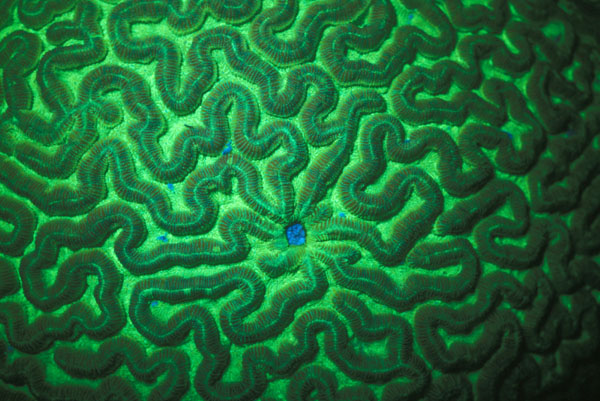
In addition to the problem of reflection, actinic lights simply dont have the intensity per unit area to produce the full fluorescing effect that you can see in Dr. Mazels images such as the brain coral (Diploria strigosa) pictured here. To see the true fluorescence, you need a filter matched to the light source to block the reflection, allowing you to see only the fluorescence. If you are interested in seeing the true fluorescent effect, you will also need a higher intensity light source (again with a filter matched to that light source), but more on this toward the end of this article.
Why Fluoresce?
A question that has long plagued scientists and curious aquarists is why certain marine organisms fluoresce. Some experts believe that it has to do with photosynthesis and the symbiotic zooxanthellae living within the tissue of the coral. Others believe it is a defensive mechanism warning predators to stay away. Some have proposed that it is a kind of sunscreen to shield the coral from harmful ultraviolet light, but at least one study observed that corals with fluorescent pigments appear to be more sensitive to bleaching events. There are a number of theories, Mazel says, but none have yet been proved. In fact, he points out, In many cases we have no idea what is doing the fluorescing.
Biomedical Research to Aquarium Husbandry
While it is unclear why some corals and other marine organisms fluoresce, the practical applications of fluorescence are only becoming clearer. Coral fluorescence is playing an incredibly valuable role in medical research, says Mazel. The genetic code for the proteins that fluoresce in corals can be inserted into the genes for different cells in fish, mice, and other laboratory subjects. The resulting fluorescence is an easy tracer for the development of organs, the effectiveness of anti-tumor treatments, and many other applications. Biomedical researchers are currently researching both Alzeimers and cancer using fluorescing proteinsjust like the ones you can witness in your aquarium.
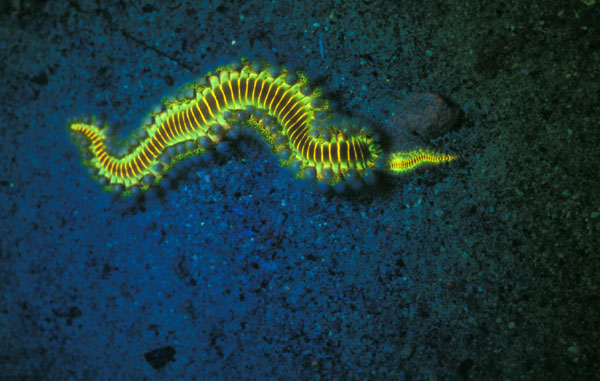
In addition to biomedical research, fluorescence has a lot of potential for the hobbyists in terms of husbandry and propagation. Because fluorescence allows the aquarist to see things he or she could not see with the naked eye under normal lighting, it is another good metric to use when assessing the overall health and stability of an aquarium. In addition, there are many marine organisms (both good and bad) that are only visible during the earliest life stages using a tool like fluorescence. In short, fluorescence can be everything from an early warning to an advanced monitoring system in the hands of the curious and innovative aquarists.
Along these same lines, recent studies have shown that fluorescence may be a very useful tool for coral farming. For example, it is close to impossible to see a newly settled coral with the naked eye until that coral is at least six months old. Using fluorescence, however, newly settled corals can be found much earlier. Unfortunately, as already mentioned, other organisms besides coral fluoresce (and not all coral fluoresces), so this is far from a surefire method for locating new coral recruits in the aquarium. Nonetheless, with experience and the right equipment, Dr. Mazel says, it is possible to distinguish coral from non-coral. This same technology is proving invaluable on natural reefs in terms of better understanding coral recruitment and making it easier to understand survivorship during the critical early life stage.
Taking Advantage of Fluorescence
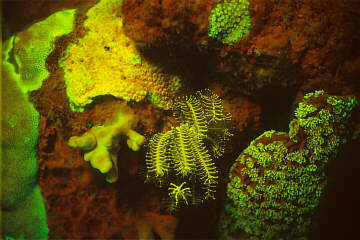
As you can see, there is a lot of potential when it comes to using fluorescence for everyone from the casual hobbyist to the serious coral farmer. The only question left is how do you take advantage of fluorescence without a) breaking the bank, b) opening a research lab, or c) needing a PhD? Actually its quite simple.
At the most basic level, you simply need a high intensity energy source (a light) and a matched filter. The best and most cost-effective equipment on the market is made by Dr. Mazels company, NightSea, and includes a high-intensity LED flashlight and a pair of filter glasses. This set-up can be purchased for less than $140, a relatively small price when you consider how much money most aquarists spend on their systems. For aquarists with a passion for photography, flashes fitted with a special excitation filter can be used in conjunction with a matched camera lens barrier filter to produce stunning effects like those shown throughout this article. (NightSea products are available through www.NightSea.com)
For coral farmers and other advanced aquarists who want to experiment with fluorescence as a husbandry tool, a modular underwater magnifier can greatly assist in identifying tiny coral recruits and other fluorescing marine organisms invisible to the naked eye. In fact, the sky is really the limit when you consider that one can now purchase underwater spectrometers (a fancy name for an instrument used to collect high resolution optical data underwater) and other equipment that used to be relegated to the lab alone. For aquarists who are also divers, a full range of equipment exist to observe and photograph the true effects of fluorescence in the natural ecosystem as well.
To read the complete interview Blue Zoo Aquatics conducted with Dr. Charles Mazel, please click here. ed.
Published 27 May 2008. Blue Zoo Aquatics
|